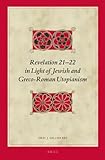Revelation 21-22 in light of Jewish and Greco-Roman utopianism / by Eric J. Gilchrest.
Material type: TextSeries: Biblical interpretation series, 0928-0731 ; v. 118.Publication details: Boston : Brill, 2013.Description: 1 online resourceContent type:
TextSeries: Biblical interpretation series, 0928-0731 ; v. 118.Publication details: Boston : Brill, 2013.Description: 1 online resourceContent type: - 9789004251540
- 9004251545
- 1299561330
- 9781299561335
- 228/.06 23
- BS2825.52 .G48 2013eb
- online - EBSCO
| Item type | Current library | Call number | URL | Status | Notes | Barcode | |
|---|---|---|---|---|---|---|---|
 eBook
eBook
|
Biblioteca "Angelicum" Pont. Univ. S.Tommaso d'Aquino Nuvola online | online - EBSCO (Browse shelf(Opens below)) | Online access | Not for loan (Accesso limitato) | Accesso per gli utenti autorizzati / Access for authorized users | (ebsco)578950 |
Browsing Biblioteca "Angelicum" Pont. Univ. S.Tommaso d'Aquino shelves, Shelving location: Nuvola online Close shelf browser (Hides shelf browser)
Includes bibliographical references and index.
Print version record.
In Revelation 21-22 in Light of Jewish and Greco-Roman Utopianism, Eric J. Gilchrest offers a creative and compelling reading of Revelation 21-22 as understood through the lens of ancient utopianism. The work is in two parts beginning with a detailed portrait of ancient utopianism based on Greco-Roman and Jewish traditions. The portrait sketches the ¿́¿topography¿́¿ of the utopian landscape, which includes a thorough account of various traditions using fourteen utopian topoi or motifs. The author then moves to a description of Revelation¿́¿s new Jerusalem in light of these two utopian traditions. With sensitivity to how this text would have been read by each utopian perspective, the author constructs a unique reading of a classic passage that highlights the variety of ways the text originally may have been heard.








